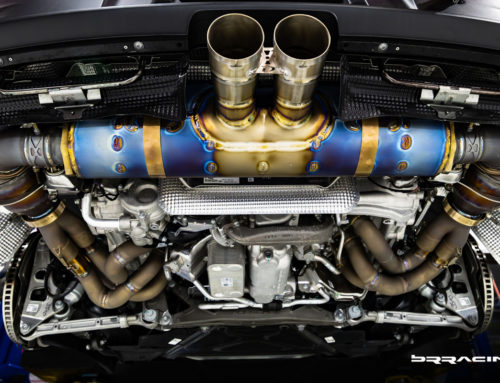There seems to be a steady stream of “special” cars from the leading sports car manufacturers. Audi has jumped into the game with a special edition of the Audi R8, to bridge the gap between the normal street version and the full blown Audi GT3 race car. Here are the details on the new car (courtesy of Motor Trend, June 2011).

Enthusiasts always seem to think what they want in a sports car is a mildly detuned race car. They want to be just like the guys on TV: banging around, scraping the pavement, arms thrashing with every bump. These are guys who have never actually spent time in a race car getting beat up, cooked, and otherwise abused while driving. Truth is, real competition cars are built with driver comfort near the bottom of the priority list. What everyday drivers really want is a car with all the flash and raw sensation of pounding around Circuit de la Sarthe, but with all the comfort they have come to expect in their family transport. Audi has gotten a pretty good handle on this desire and has built an R8 to scratch that itch.

The R8 GT isn’t terribly different from a run-of-the-mill R8 5.2 in a mechanical sense. The engine delivers slightly more power — 35 more to be exact — for a total of 560 horsepower from a freer-flowing exhaust and remapped engine tuning. Audi has shaved roughly 220 pounds out of the aluminum wonder. A thinner windshield, polycarbonate rear glass, a carbon-fiber engine cover, and one-piece FRP seats were all easy swaps. Replacing the standard magnetorheological dampers with ride-height adjustable coilovers subtracted further weight and allows owners to weight-balance cars to optimize handling. Other than that, the magic comes from strapping yourself into those one-piece seats with a Schroth four-point harness with 3-inch belts, just like the guys on TV. Sadly, regulations don’t allow Audi to use Schroth’s camlock buckle, and instead it has a more DOT-friendly push-button release.

The GT isn’t hard to get in and out of, but there is a procedure. The seats are fairly deep, but not nearly as deep or as narrow as actual race versions. To get in, put your right foot on the right side of the floor on the opposite side of the steering wheel. As you squat into the car, brace your left hand on the door sill. With your right hand on the wheel, gracefully fall into the seat. Did I mention that before any of this, you need to drape the harness belts out over the seat so you don’t end up sitting on them? Now that you are in, you probably need to hike your pants down as the sitting process has given you a wedgie. Race cars go full atomic with deeper seats and grippier Nomex material, but Audi went with leather for the GT. Now start with the Adjust the lap belt and tighten it to sit as low on your hips as possible. Now fasten the shoulder belts. There aren’t any straps between your legs, so if you over-tighten the shoulder belts, you will just pull up the lapbelt. Now you’re in, and you can’t reach the door to shut it. That’s what crew chiefs and valets are for.

The R8 GT is a completely different beast on the track than it is on the street. On the street, it feels balanced and neutral. It is possible to get the back end to rotate around on throttle at lower speeds in a completely predictable manner. At higher speeds, mild understeer keeps things safe and allows you to easily pull the car back in when you get a little too enthusiastic. The power is mesmerizing, and on-ramps blow by in an orchestral blur of sound and fury. Sitting low in the R8 gives you the sensation of being down in the car, not on top of it. You never feel like you are being pulled out of the seat by your shoulders, but more like you’re checking your hip in the side of the car. The R8 rolls around you, not under you. Audi managed to capture the feeling of sitting down in the tub of a Le Mans race car. You really can trick yourself into thinking you’re charging out of the last corner on the last lap to take the checkered flag, when in reality you are just heading to the store for milk. It’s all about the experience.

At the test track, it feels different. Suddenly the tuning that makes it so predictable on the street becomes a slight downfall. That light, safe understeer puts up stubborn resistance to changing direction. Feeding in the throttle too early results in washing out the front end, then dialing out steering and throttle to get back on line. If you’re patient, you can go in hot, carry speed past the center of the turn, get on the throttle, then back out just barely throwing the weight on the front tires while giving the steering a slight flick, and bury the throttle. The back end will step out and you need fast hands to keep up.
Audi recommends unusually high front tire pressures for the GT, so we ran at 39 psi front and 36 psi rear. Tire wear showed signs of overinflation in front, and we imagine that with some playing around, the car could be much more neutral. But our testing procedures dictate we don’t vary from factory recommended pressures, so it is hard to comment on effectiveness. We would assume any owner who tracks a car like this will have the skills and knowledge (or a crew that does) to make the proper adjustments. The R8 GT ran a 23.9-second run on our figure eight and was able to sustain .95 average g, which puts it in line with the some of the best cars we’ve tested. The extremely rigid chassis has so much potential because of its low center of gravity and low polar-moment of inertia, that we have to think that a proper setup would see those numbers even higher.
The GT is equipped with standard launch control, which helps it achieve a very respectable 3.5-second 0-60-mph time. This isn’t a torque monster like some of the bigger displacement or forced induction competition, so it doesn’t launch nearly as hard. The R-tronic shifts fast, throwing your head back into the headrests. The quarter mile flashes by in 11.5 seconds at 125 mph. For comparison’s sake, we have tested a GT2 RS that ran it in 11.2 seconds at 129 mph, and the brutal ZR1 ran a similar 11.5 seconds at 127 mph. The 0-60-mph sprint for the GT2 RS was a staggering 3.3 seconds, while both the R8 GT and the ZR1 both ran 3.5 seconds. It is worth pointing out that the GT2RS does these numbers using a 3.6-liter flat-six supplemented with two turbochargers, while the ZR1 is using a 6.2-liter supercharged V-8. The Audi is able to rip through these numbers with a naturally aspirated 5.2-liter V-10.
In braking, the Audi suffers again from just not enough front tire. While 102 feet from 60-0 mph is amazing, the ZR1 can do it in 99 feet. But the GT2RS matches the Audi in distance, while the often-deified Lexus LFA takes an even longer 106 feet. The Audi’s carbon-ceramic brakes showed no signs of fading through repeated stops. On the street they tend to squeal and grumble a bit, especially after some abuse at the track, but the pedal feel never falters.
Audi will build 333 of the R8 GTs, with 90 of those slated to make it to the United States. The base price is around $200,000, which might seem steep. But this is a very exclusive vehicle that delivers a driving experience you won’t get from other vehicles, even if they are faster. It isn’t quite a race car, but you quickly get the sensations of one. Before you write that considerable check, you might also want to factor in the cost of the champagne you will be spraying every day when you get home from work in the R8 GT.













Hey! I hope you don’t mind but I decided to submit your website: https://www.brrperformance.com/www/?p=1462 to my on-line directory. I used, “Audi releases R8 GT for track addicts &” as your web site headline. I hope this is okay with you. If you’d like me to change the title or remove it completely, email me at tadek.walec@o2.pl. Many thanks. Kindest regards http://kulturistikadoplnky.cz/